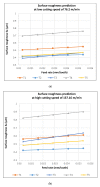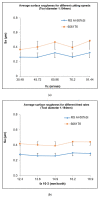Investigation on Surface Quality of a Rapidly Solidified Al-50%Si Alloy Component for Deep-Space Applications
- PMID: 32756338
- PMCID: PMC7436292
- DOI: 10.3390/ma13153412
Investigation on Surface Quality of a Rapidly Solidified Al-50%Si Alloy Component for Deep-Space Applications
Abstract
To meet the requirements for high-performance products, the aerospace industry increasingly needs to assess the behavior of new and advanced materials during manufacturing processes and to ensure they possess adequate machinability, as well as high performance and an extensive lifecycles. Over the years, industrial research works have focused on developing new alloys with an increased thermal conductivity as well as increased strength. High silicon content aluminum (Al-Si) alloys, due to their increased thermal conductivity, low coefficient of thermal expansion, and low density, have been identified as suitable materials for space applications. Some of these applications require the use of intricate parts with tight tolerances and surface integrity. These challenges are often tied to the machining conditions and strategies, as well as to workpiece materials. In this study, experimental milling tests were performed on a rapidly solidified (RS) Al-Si alloy with a prominent silicon content (over 50%) to address challenges linked to material expansion in deep space applications. The tests were performed using a polycrystalline cubic boron nitride (PCBN) tool coated with amorphous diamond to reduce tool wear, material adhesion, surface oxidation, and particle diffusion. The effects of cutting parameters on part surface roughness and microstructure were analyzed. A comparative analysis of the surface with a conventionally utilized Al6061-T6 alloy showed an improvement in surface roughness measurements when using the RS Al-Si alloy. The results indicated that lower cutting speed and feed rate on both conventional and RS Al-Si alloys produced a better surface finish. Reduced vibrations were also identified in the RS Al-Si alloy, which possessed a stable cutting time at low cutting speeds but only displayed notable vibrations at cutting speeds above 120 m/min.
Keywords: high silicon; machining; microstructure change; milling; rapidly solidified aluminum; surface finish.
Conflict of interest statement
The authors declare no conflict of interest.
Figures



















References
-
- Haghshenas M., Jamali J. Assessment of circumferential cracks in hypereutectic Al-Si clutch housings. Case Stud. Eng. Fail. Anal. 2017;8:11–20. doi: 10.1016/j.csefa.2016.11.003. - DOI
-
- Ye H. An overview of the development of Al-Si-Alloy based material for engine applications. J. Mater. Eng. Perform. 2003;12:288–297. doi: 10.1361/105994903770343132. - DOI
-
- Horváth R., Sipos S. Machinability of high silicon content aluminum alloys; Proceedings of the XV Young Technologies Scientific Session; Cluj-napaoca, Romania. 25–26 March 2010; pp. 25–26.
-
- Zamani M. Ph.D.Thesis, comprehensive summary. Jönköping University, School of Engineering; Jönköping, Sweden: 2017. Al-Si Cast Alloys-Microstructure and Mechanical Properties at Ambient and Elevated Temperatures.
-
- MDA Innovation in Space and Defence. [(accessed on 12 July 2020)]; Available online: https://mdacorporation.com/corporate/
LinkOut - more resources
Full Text Sources

